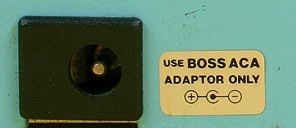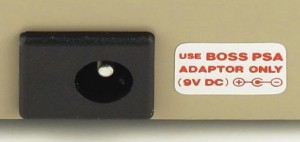Most of the Boss pedals require the normal PSA adapter, while some has a sticker that says ”ACA” on them. What’s the difference, and how can I make them work in my setup? To answer these questions and a few more, let’s start at the beginning.
History

In 1978, Boss launched the Compact pedal line, and all the early products were small current consumers. The OD-1 draws about 4mA, and the CE-2 (introduced in 1979) draws about 8mA. The first adapter Boss sold to go with the pedals was called the ”ACA-xxx” (where ”xxx” denotes the mains voltage, so the US one was called ”ACA-120”, while the EU one was called ”ACA-230”). This adapter was unregulated (as the current draw grows, the output voltage drops) and even though they were labeled ”9vDC”, they did put out roughly 12 volts DC at a normal load. So each pedal was fitted with a diode and a resistor, to drop the incoming voltage to roughly 9 volts DC.
As the pedal range grew, the current consumption of each new pedal grew as well. The larger current draw of the new pedals didn’t fit the unregulated adapter system very well – remember that the voltage varies with the load – so Boss decided to start designing the new pedals to accept a regulated power source instead. The trick with regulation is that the voltage stays constant from no load all the way up to the max capacity of the regulator (in the case of the PSA, 200mA). And so the PSA-xxx was born!

For years, the unregulated ACA and regulated 9vDC PSA adapters – and the pedals they powered – lived side by side. As the older (ACA) designs were discontinued, their newer replacements were of course PSA powered. In some cases, when redesigning an existing pedal (for instance when various circuits became obsolete and had to be replaced), Boss also made that pedal PSA-spec. The resistor and diode were simply no longer included in the redesigned circuit. And in august 1997 Boss finally made all the pedals compatible with the PSA adapter. In those pedals that still used the same circuit board design, the resistor and diode were simply replaced with jumpers (you can still find them in a brand new SD-1, for instance). These pedals all carry a ”PSA” sticker.
Which power supply do I need?
So, all Boss compact pedals made after mid 1997 use the PSA (9vDC, regulated) power supply. But what about the ACA ones made before that (the ones that still have the ACA sticker)? Do I need to buy the ACA adapter for those?
Well, Boss still sells the ACA adapter, labelled 9vDC. But as mentioned before, that doesn’t mean it actually puts out 9vDC. This is due to how unregulated power supplies work (they start high and drop the voltage as the load increases) and some list the voltage at max load, and others at a nominal load. Anyway, at the low loads generated by these pedals, the voltage will be a healthy 12 or so volts.
But you don’t have to buy a separate unregulated adapter – if you have a power supply that can provide a regulated 12vDC output (Voodoo Lab were early adopters to this, with their Pedal Power unit), you can use that. But you can also modify your pedal the same way Boss did, to make it compatible with a regulated 9vDC (PSA) supply – that’s what I do, and here’s how you can do it too. But there is another way…
The daisy chain thing
When powering a Boss ACA (old-style) pedal from a 9v PSA adapter, you will probably notice that the LED barely lights up. This is normal and expected behaviour, since the 9 volts fed to the pedal really is too little – it wants roughly 12 volts on the adapter input, remember? But when the power is being provided via a daisy-chain, with other PSA pedals connected to the chain and with signal cables connecting them, the LED suddenly lights up as normal… What happens is that all the pedals in the daisy chain share a common ground, which bypasses the voltage limiting components in the ACA pedal(s), causing the pedal to receive the full 9 volts. This trick works with any power supply where the outputs share a common ground – daisy chain setups, DC Brick etc.
Obviously, this won’t work with an isolated power supply like the Voodoo Lab Pedal Power 2+, since the isolated outputs prevent common grounds from forming. This is why that power supply – and others like it – has a 12 volt/ACA setting on some of its outputs.
TL/DR version:
- If it says ”PSA” on the sticker next to the adapter jack, use a 9 volt regulated supply.
- If it says ”ACA” on the sticker, and the pedal has not been modified, it will need 12 volts on the adapter jack, rather than 9. Unless you are using a daisy chain or power supply with common ground for all outputs (original DC Brick, Joyo JP-02, PowerPad etc). In that case, the pedal will work with 9 volts, as long as there’s a ’proper’ 9 volt pedal in the chain with it. And provided that there are signal cables connecting the pedals as well.
- Unless the pedal is super rare and to be kept strictly in collector’s condition, I always recommend modifying it to PSA specs. Heck, I do that even if it’s a rare pedal, as long as it’s something I want to actually use. In those cases, I save the components and tape them to the inside of the box, so they can be put back if need be. 🙂
You’ll know instantly if it needs 12 volts or not, or for that matter if an ACA pedal has already been modified – if the LED lights up equally bright as with the battery powering it, the pedal will work with 9 volts. If it is markedly less bright when on adapter power, the pedal is still ACA spec.